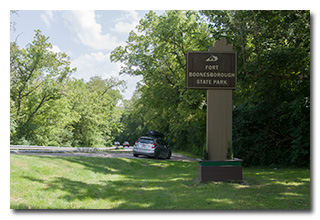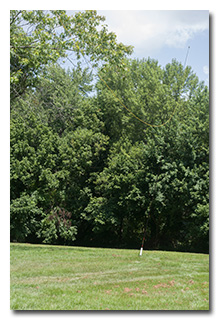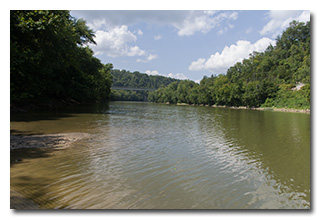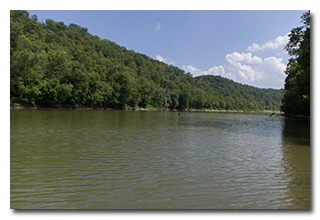Description
On Sunday, August 10, 2025, one member of the Southeast Ohio Radio Adventure Team performed a successful activation of Fort Boonesborough State Park (US-1256) in Kentucky as part of the Parks on the Air (POTA; link) program.
On the way back to Ohio following participation as a radio operator in Boone Forest Rally, and following a successful activation of Miller Welch Wildlife Management Area (link), Eric McFadden, WD8RIF, stopped at Fort Boonesborough State Park for his second activation of the park. Eric was accompanied by his friend Len Touth, W8VQ, who performed his first activation of the park.
Eric and Len arrived at the state park at about 1645 UTC, choosing first to look at the parking area at the reconstructed fort for their activations.Deciding that the fort's parking area was too crowded and lacked sufficient shade, they continued to the picnic shelters near the boat ramp. Finding picnic shelter #2 to be unoccupied and in the middle of a nice grassy area suitable for antennas, the pair selected this is as their operating location.
Before setting up their stations, Eric and Len enjoyed a picnic lunch in the shade of the picnic shelter. After the picnic lunch, Len used Eric's KX2 as a reference receiver to calibrate his (tr)uSDX transceiver's T/R offset, having recently learned that the little rigs ship without this procedure having been performed—and, yes, Len's rig's offset was found to have been way off.
Next came set up of the two stations. Having noticed the power lines passing near the west side of picnic shelter #2, Len and Eric deployed their antennas in the yard to the east of the picnic shelter, Len deploying a lightweight 40m EFHW as an inverted-vee supported on a Goture Red Fox telescoping carbon fiber mast, and Eric deploying his 58' EFRW as a sloper to the top of his Goture Red Fox Super Hard 720 carbon-fiber mast held upright on a spike, laying three 17' counterpoise wires directly on the ground.
Choosing opposite ends of the picnic shelter, Len set up his (tr)uSDX transceiver on a picnic table, and Eric set up his Elecraft KX2 on another picnic table, and each were on the air about 1715 UTC.
Strangely, Eric had cell-signal (Verizon), but Len had no cell-signal (T-Mobile). Eric would be able to access POTA Spots to spot himself and to identify Park-to-Park (P2P) QSO opportunities, but Len wouldn't be able to. Eric promised Len that he would ensure that Len was spotted.
Given that the solar numbers were about the same as at their activation earlier in the afternoon (SFI=140, SN=141, A-Index=47, K-Index=3) Eric and Len didn't realize that HF propagation conditions were much worse than they had been for their activation earlier in the day. In fact, an R1-class radio black-out was underway, and Eric and Len were to find that it would take them each about ninety minutes to validate their activations of Fort Boonesborough State Park.
Len started his operation on 20m using his (tr)uSDX station, while Eric began his operation on 40m using his Elecraft KX2. Eric was quickly auto-spotted on POTA Spots but Len, who had also announced his upcoming operation on POTA Spots, it turns out, wasn't auto-spotted.
Eric's first QSO on 40m came at 1721 UTC with W2GIW in New Jersey. His second QSO came at 1722 UTC and was an easy P2P QSO with Len, who had left 20m for a moment to have the QSO with Eric. Eric's third QSO came at 1729 UTC with AC0MP in Missouri. This was followed at 1730 UTC by a QSO with KB3AAY in Maryland. Eric's fifth QSO came at 1731 UTC with N8JMS who was activating Deer Creek State Park (US-1945) in Ohio.
Meanwhile, Len struggled to make QSOs on 20m and, in fact, had made only one QSO other than his P2P QSO with Eric. It was at this point that Eric noticed Len hadn't yet been auto-spotted on POTA Spots. Eric tried six or eight times to use his smartphone to spot Len, but his attempts were rejected each time, and he eventually resorted to sending texts to his father (W8EOG), Thomas Witherspoon (K4SWL), and Mike Hansgen (K8RAT), asking for assistance. Both W8EOG and K4SWL were able to successfully spot Len, but only after Len had been calling CQ for about twenty minutes, unspotted.
Now that Len had been spotted and would, they hoped, have more success in making QSOs, Eric paused to hunt P2P QSOs, and at 1733 UTC he made a P2P QSO on 20m with Len.
Even after having been spotted on POTA Spots, Len struggled to make QSOs with his (tr)uSDX and 40m EFHW antenna, so Eric offered him the KX2 and 58' EFRW antenna, and Len accepted. Either the rig-swap worked, or conditions suddenly improved, because Len finally began making QSOs.
While Len operated on 20m using Eric's KX2, Eric hooked his Elecraft KH1 to Len's 40m EFHW and continued operating on 40m. First, he hunted, and at 1817 UTC, he made a P2P QSO on 40m with KE2BKW at Nanticoke Lake Multiple Use Area (US-5211) in New York. After failing to work any other activators on any bands (except 20m, so he wouldn't interfere with Len), he began running a 40m frequency again, managing to make two QSOs, one at 1838 UTC with KO4BHX in North Carolina, and the second at 1840 UTC with WC3O in Pennsylvania.
By this point, Len had already validated his activation with eleven QSOs, but Eric still needed one more QSO to get his ten, so the pair coordinated to make a P2P QSO on 30m at 1850 UTC and, for good measure, to make a P2P QSO on 17m at 1851 UTC.
In all, Eric made eleven QSOs, with six P2P QSOs, in just under ninety minutes of on-air time. All of Eric's QSOs were CW and were made at five watts output.
Len validated his activation with thirteen QSOs. All of Len's QSOs were CW, with about 2 watts output from the (tr)uSDX and 5 watts output from the KX2.
After they tore down their stations and re-packed the car for the trip back into Ohio, Eric and Len viewed the Kentucky River from the park's boat ramp.
Eric also submitted his log to the World Wide Flora and Fauna in Amateur Radio (WWFF; link) program.
(return)





